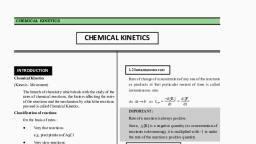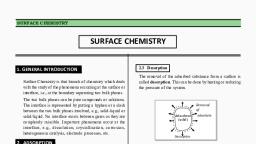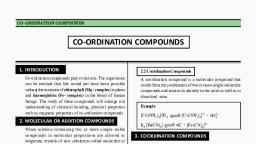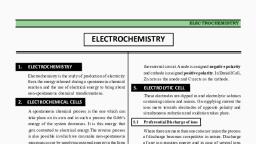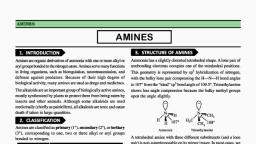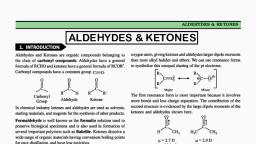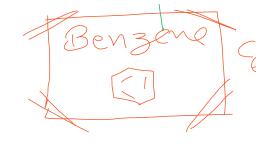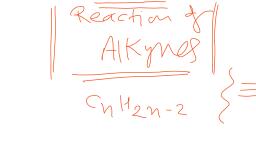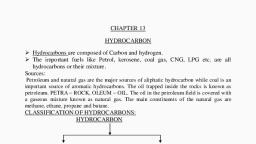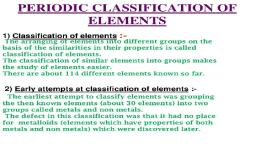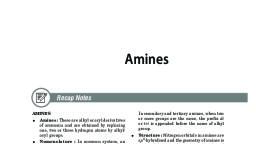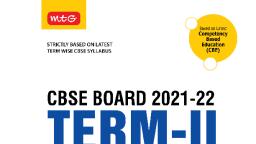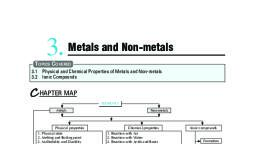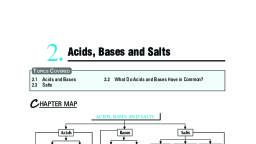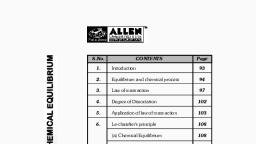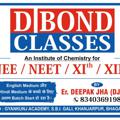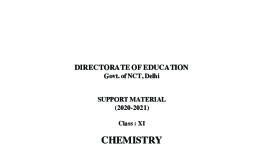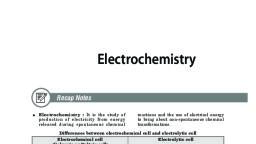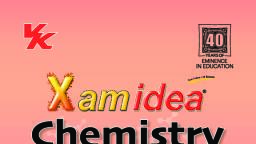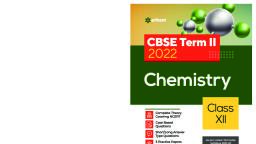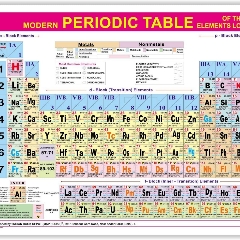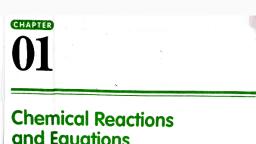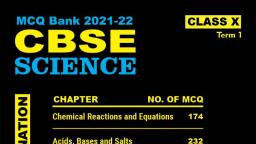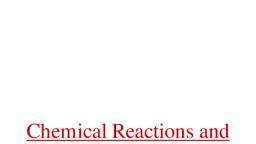Page 1 :
Ved_Goswami, , \ 14-Sep-2021, , 1, , Proof-1�, , Reader’s Sign _______________________, , Date __________, , Chemical Reactions and Equations, , Topics Covered, 1.1 Chemical Reaction and Chemical Equation, 1.3 Corrosion and Rancidity, , 1.2 Types of Chemical Reactions, , C hapter map, CHANGES AROUND US, Physical changes, , Chemical, changes/reactions, , Chemical equation, Skeletal, equation, , Oxidising agent, , Balanced, equation, , 1. Combination reaction, 2. Decomposition reaction, 3. Displacement reaction, 4. �Double displacement reaction, (Precipitation reaction), , Law of, conservation, of mass, , Oxidation, , Reduction, , Air tight, packing, , Reducing agent, Rancidity, , Methods of, Prevention, , Redox reaction, Corrosion, , Antioxidants, , Inert atmosphere, , Topic 1. Chemical Reaction and Chemical Equation, , Chemical reaction: It takes place by bond breaking between atoms and formation of new bonds, between different atoms. New substances with different properties are formed, e.g. Iron reacts, with oxygen in the presence of moisture to form reddish brown Iron (III) oxide., 4Fe(s) + 3O2 ( g) Moisture, → 2Fe2 O3 (s), , ( greyish black), , Oxygen, , (reddish brown), , Chemical equation: It is the symbolic representation of a chemical reaction, with the help of, symbols of elements and formulae of compounds., burning, 2Mg(s) + O2(g), 2MgO(s), , →, , , (Magnesium) (Oxygen), , , , (Magnesium oxide), , + heat + light, , In physical change, no new substance is formed e.g., melting of ice, evaporation of water.
Page 2 :
\ 14-Sep-2021, , Ved_Goswami, , Proof-1�, , Reader’s Sign _______________________, , Date __________, , Writing Chemical Equation: How to Write a Chemical Equation, , (i) Reactants must be written on the left hand side with the help of symbols of elements and, formulae of compounds., (ii) Products should be written on the right hand side., (iii) Physical state of the reactants must be written as ‘s’ for solid, ‘l’ for liquid, ‘g’ for gas, ‘aq’, for aqueous, ‘dil’ for dilute and ‘conc’ for concentrated., (iv) Reaction conditions must be written on the arrow., (v) Reactants and products are separated by arrow., (vi) Write (+) sign between two or more reactants or products., , Balancing of chemical equation, Skeletal Equation: The equation which just shows the chemical substances involved without, , considering their number (i.e., equation is not balanced) is called skeletal equation, e.g., Mg(s) + O2(g) → MgO(s), Balanced Equation: The equation in which the number of atoms of each element on the reactants, and products side are equal so as to follow the law of conservation of mass, e.g., burning, → 2MgO(s) + heat + light, 2Mg(s) + O2(g) , , Law of conservation of mass: The total mass of the reactants must be equal to the total, mass of products. That is why, we balance every chemical equation., (i) C(s) + O2(g) → CO2(g), 12g + 32g = 12 + 2 (16) = 44g, (ii) Fe + H2O → Fe3O4 + H2, Step I: There are 3 Fe atoms on RHS, so multiply Fe with 3 on the reactant side., 3Fe + H2O → Fe3O4 + H2, Step II: There are four oxygen atoms on RHS, so multiply H2O with 4 on LHS., 3Fe + 4H2O → Fe3O4 + H2, Step III: There are 8 hydrogen atoms on LHS, so multiply H2 by 4 on RHS., 3Fe + 4H2O → Fe3O4 + 4H2, The equation is now balanced., 3Fe(s) + 4H2O(g) → Fe3O4(s) + 4H2(g), , EXERCISE 1.1, I. Multiple Choice Questions, Choose the correct answer from the given options., 1. Which of the following is not a physical change?, (a) Boiling of water to give water vapours, (b) Melting of ice to give water, (c) Dissolution of salt in water, (d) Combustion of Liquefied Petroleum Gas (LPG), 2. Which one of the following processes involve chemical reactions?, (a) Storing of oxygen gas under pressure in a gas cylinder, (b) Liquefaction of air, (c) Keeping petrol in a china dish in the open, (d) Heating copper wire in presence of air at high temperature, , (1 Mark)
Page 3 :
\ 14-Sep-2021, , Ved_Goswami, , Proof-1�, , Reader’s Sign _______________________, , Date __________, , 3. In which of the following chemical equations, the abbreviations represent the correct, states of the reactants and products involved at reaction temperature?, (a) 2H2(l) + O2(l) → 2H2O(g), (b) 2H2(g) + O2(l) → 2H2O(l), (c) 2H2(g) + O2(g) → 2H2O(l), (d) 2H2(g) + O2(g) → 2H2O(g), 4. Cu + x HNO3 → Cu(NO3)2 + y NO2 + 2H2O. The values of ‘x’ and ‘y’ are, (a) 3 and 5, (b) 8 and 6, (c) 4 and 2, (d) 7 and 1, [CBSE 2020], 5. The compound obtained on reaction of iron with steam is/are:, (a) Fe2O3, (b) Fe3O4, (c) FeO, (d) Fe2O3 and Fe3O4, �[CBSE 2020], 6. An element ‘X’ reacts with O2 to give a compound with a high melting point. This, compound is also soluble in water. The element ‘X’ is likely to be:, (a) iron, (b) calcium, (c) carbon, (d) silicon, [CBSE 2020], 7. Identify ‘x’, ‘y’ and ‘z’ in the following reaction:, ( y), → 2KCl(x) + 3O2(z)�[CBSE 2020], 2KClO3(x) , (a) x = gas; y = reaction condition; z = gas, (b) x = solid; y = liquid; z = gas, (c) x = number of moles of KClO3; y = reaction condition; z = no. of molecules of oxygen, (d) x = physical state of KClO3 and KCl; y = reaction condition; z = physical state of O2., 8. In which of the following the identity of initial substance remains unchanged?, (a) Curdling of milk, (b) Formation of crystals by process of crystallisation, (c) Fermentation of grapes, (d) Digestion of food.�, [CBSE 2020], 9. What happens when dilute hydrochloric acid is added to iron filings? Tick the correct, answer., (a) Hydrogen gas and iron chloride are produced., (b) Chlorine gas and iron hydroxide are produced., (c) No reaction takes place., (d) Iron salt and water are produced., 10. A balanced chemical equation is in accordance with, (a) Avogadro’s law, (b) law of multiple proportion, (c) law of conservation of mass, (d) law of gaseous volumes, II. Assertion-Reason Type Questions, (1 Mark), For question numbers 1 to 4, two statements are given—one labeled as Assertion (A) and, the other labeled as Reason (R). Select the correct answer to this question from the codes, (a), (b), (c) and (d) as given below:, (a) Both ‘A’ and ‘R’ are true and ‘R’ is correct explanation of the assertion., (b) Both ‘A’ and ‘R’ are true but ‘R’ is not the correct explanation of the assertion., (c) ‘A’ is true but ‘R’ is false., (d) ‘A’ is false but ‘R’ is true., 1. Assertion: Mg + O2 → MgO is skeletal equation., , Reason: The equation is not balanced., 2. Assertion: Following is a balanced chemical equation for the action of steam on iron:, , 3Fe + 4H2O → Fe3O4 + 4H2, , Reason: The law of conservation of mass holds good for a chemical equation., [CBSE 2020]
Page 4 :
\ 14-Sep-2021, , Ved_Goswami, , Proof-1�, , Reader’s Sign _______________________, , Date __________, , 3. Assertion: The balancing of chemical equation is based on law of conservation of mass., , Reason: Total mass of reactants is equal to total mass of products., 4. Assertion: The following chemical equation:, 7, 2C6H6 + O2 , → 4CO2 + 3H2O, 2, , , is a balanced chemical equation., , Reason: In a balanced chemical equation, the total number of atoms of each element, must be equal on both sides of the equation., , Answers 1.1, I. 1., , 2., , 3., , 4., , 5., , 6., , 7., , 8., , 9., , (d) Combustion of LPG is chemical change because new substances are being formed., Heat, (d) 2 Cu (s) + O2 (g) , → 2CuO (s), (c) 2H2(g) + O2(g) → 2H2O(l), (c) 4 and 2, (b) 3Fe + 4H2O → Fe3O4 + 4H2(g), (b) Calcium. 2Ca + O2 → CaO; CaO + H2O → Ca(OH)2, (d) x = physical state of KClO3 and KCl; y = reaction condition; z = physical state of O2., (b) It is physical change, no new substance is formed., (a) �The solution will become pale green due to iron (II) chloride and colourless, odourless, hydrogen gas will be evolved., Fe(s) + 2HCl(dil) → FeCl2(aq) + H2(g), , 10. (c) law of conservation of mass, II. 1. (a) Both ‘A’ and ‘R’ are true and ‘R’ is correct explanation of the assertion., , 2. (a) Both ‘A’ and ‘R’ are true and ‘R’ is correct explanation of the assertion., , 3. (a) Both ‘A’ and ‘R’ are true and ‘R’ is correct explanation of the assertion., , 4. (d) ‘A’ is false but ‘R’ is true., The correct balanced chemical equation is:, 2C2H6 + 7O2 → 4CO2 + 6H2O, , Topic 2. Types of Chemical Reactions, , 1. Combination reactions: Those reactions in which two or more elements or compounds, , combine to form one or more compounds are called combination reactions, e.g., 340 atm, , CO(g) + 2H2(g) , → CH3 OH(l), Methanol, , 2. Decomposition reactions: Those reactions in which a compound breaks into simpler, substances (elements or compounds) are called decomposition reactions, e.g., 2Cu(NO3 )2 (s) Heat, → 2CuO(s) + 4NO2 ( g) + O2 ( g), Black, , Blue, , Brown, , (colourless), , (i) Thermal decomposition: Those decomposition reactions in which compound breaks down, into simpler substances by heat, e.g., Heat, , CaCO3(s) , → CaO(s) + CO2(g), (ii) Photo-chemical decomposition: Those decomposition reactions in which sunlight is used, for decomposition of a compound, e.g., , 2AgCl(s) Sunlight, → 2Ag (s) + Cl2 ( g), (white), , (grey), , greenish yellow
Page 5 :
\ 14-Sep-2021, , Ved_Goswami, , Proof-1�, , Reader’s Sign _______________________, , Date __________, , Activity:, •T, � ake 2 g of AgCl in China dish formed by, reaction of AgNO3(aq) and NaCl(aq). It is, white in colour., • �Place the China dish in sun light., • �The colour will change to grey due to formation, of Ag(s) and greenish yellow chlorine gas will, be involved., , (iii) Electrolysis (Decomposition by electricity): Those decomposition reactions in which a, compound is broken down into simpler substances by passing electric current through it,, in aqueous solution or molten state, e.g., Electricity, 2H2O(l) , → 2H2(g) + O2(g), , , , 3. Displacement reactions: Those reactions in which a more reactive element can displace, a less reactive metal from its salt solution are called displacement reactions, e.g., Cu(s) + 2AgNO3 (aq) → Cu(NO3 )2 (aq) + 2Ag(s), , Reddish brown, , Blue, , Shiny metal, , 4. Double displacement reactions: Those reactions in which two compounds exchange, , their ions to form two new compounds are called double displacement reactions. If one of the, products formed is a solid (insoluble in water) it is also called precipitation reaction. e.g., (i) Double displacement reaction:, , NaOH(aq) + HCl(aq) → NaCl(aq) + H2O(l), (ii) Precipitation reaction:, , AgNO3(aq) + KBr(aq) → AgBr(s) + KNO3(aq), Yellow ppt., , 5. Exothermic reactions: Those reactions in which heat is evolved are called exothermic, reactions, e.g. respiration is an exothermic reaction., C6H12O6(s) + 6O2(g) → 6CO2(g) + 6H2O(l) + Heat, , 6. Endothermic reactions: Those reactions in which heat is absorbed are called endothermic, Heat, reactions, e.g. 2KClO3(s) , → 2KCl(s) + 3O2(g), 7. Oxidation reactions: Those reactions in which oxygen is added or hydrogen is removed, are called oxidation reactions. e.g., , 2Cu(s) + O2 ( g) Heat, →, , (Reddish brown), , 2CuO(s), , Copper oxide (Black), , In electronic concept, oxidation reactions involve loss of electrons, e.g., , Fe2+(aq) → Fe3+(aq) + e–, , 8. Reduction reactions: Those reactions in which hydrogen is added or oxygen is removed, , are called reduction reactions, e.g. 2Na(s) + H2(g) → 2NaH(s), In electronic concept, reduction reactions involve gain of electrons, e.g., , Fe3+(aq) + e– → Fe2+(aq), 9. Redox reactions: Those reactions in which reduction as well as oxidation take place, Heat, simultaneously are called redox reactions, e.g. CuO(s) + H2 ( g) → Cu(s) + H2 O(l), Black, , Reddish brown, , Redox reactions involve loss and gain of electrons simultaneously, e.g., Zn(s) + Fe2+(aq) → Zn2+(aq) + Fe(s)
Page 6 :
\ 14-Sep-2021, , Ved_Goswami, , Proof-1�, , Reader’s Sign _______________________, , Date __________, , 10. Oxidising agent: Those substances which can add oxygen or remove hydrogen are called, oxidising agents, e.g. CuO, O2, MnO2, KMnO4. It can gain electrons e.g., non-metals., 11. Reducing agent: Those substances which can add hydrogen or remove oxygen are called, reducing agents, e.g. H2, NaH, NH3. It can lose electrons e.g., metals., , EXERCISE 1.2, I. Multiple Choice Questions, , (1 Mark), , Choose the correct answer from the given options., 1. A dilute ferrous sulphate solution was gradually added to the beaker containing, acidified permanganate solution. The light purple colour of the solution fades and finally, disappears. Which of the following is the correct explanation for the observation?, (a) KMnO4 is an oxidising agent, it oxidises FeSO4, (b) FeSO4 acts as an oxidising agent and oxidises KMnO4, (c) The colour disappears due to dilution; no reaction is involved, (d) KMnO4 is an unstable compound and decomposes in presence of FeSO4 to a colourless, compound., 2. Which among the following statement(s) is(are) true? Exposure of silver chloride to, sunlight for a long duration turns grey due to, I. the formation of silver by decomposition of silver chloride, II. sublimation of silver chloride, III. formation of chlorine gas from silver chloride, IV. oxidation of silver chloride, (a) I only, (b) I and III, (c) II and III, (d) IV only, 3. Barium chloride on reacting with ammonium sulphate forms barium sulphate and, ammonium chloride. Which of the following correctly represents the type of the reaction, involved?, I. Displacement reaction, II. Precipitation reaction, III. Combination reaction, IV. Double displacement reaction, (a) I only, (b) II only, (c) IV only, (d) II and IV, 4. Electrolysis of water is a decomposition reaction. The mole ratio of hydrogen and oxygen, gases liberated during electrolysis of water is, (a) 1:1, (b) 2:1, (c) 4:1, (d) 1:2, 5. Formation of CuO from copper and oxygen denotes, (a) Reduction , (b) Oxidation, (c) Redox reaction , (d) None of these, 6. Rahul took some zinc granules in a test tube and added dil HCl to it. He observed that, the colour of Zn granules changed to, (a) Yellow, (b) Brown, (c) Black, (d) White, 7. Four students were asked to study the reaction between solution of BaCl2 and sodium, sulphate. On mixing the solutions of the two salts in a test tube, they reported their, experiments as follows:, (a) The colour of mixture became brown, (b) The solution forms separate layers, (c) A colourless mixture is obtained, (d) A white substance settles at the bottom, ∆, , 8. 2KClO3 →, 2KCl + 3O2 is a, (a) Decomposition reaction, (b) Combination reaction, (c) Displacement reaction, (d) Redox reaction
Page 7 :
\ 14-Sep-2021, , Ved_Goswami, , Proof-1�, , Reader’s Sign _______________________, , Date __________, , 9. Which of the following reactions is an endothermic reaction?, (a) Burning of coal, (b) Decomposition of vegetable matter into compost, (c) Process of respiration, (d) Decomposition of calcium carbonate to form quick lime and carbon dioxide, �[CBSE Sample Paper 2019-2020], 10. Calcium oxide reacts vigorously with water to produce slaked lime., CaO(s) + H2O(l) → Ca(OH)2(aq). This reaction can be classified as:, (A) Combination reaction, (B) Exothermic reaction, (C) Endothermic reaction, (D) Oxidation reaction, Which of the following is a correct option?, (a) (A) and (C) , (b) (C) and (D), (c) (A), (C) and (D) , (d) (A) and (B)�, [CBSE 2020], 11. When hydrogen sulphide gas is passed through a blue solution of copper sulphate, a black, precipitate of copper sulphide is obtained and the sulphuric acid so formed remains in, the solution. The reaction is an example of a:, (a) Combination reaction, (b) Displacement reaction, (b) Decomposition reaction, (d) Double displacement reaction, [CBSE 2020], 12. In a double displacement reaction such as the reaction between sodium sulphate solution, and barium chloride solution:, (A) exchange of atoms takes place, (B) exchange of ions takes place, (C) a precipitate is produced, (D) an insoluble salt is produced, The correct option is:, (a) (B) and (D) , (b) (A) and (C), (c) only (B) , (d) (B), (C) and (D)�, [CBSE 2020], II. Assertion-Reason Type Questions, (1 Mark), For question numbers 1 to 10, two statements are given—one labeled as Assertion (A) and, the other labeled Reason (R). Select the correct answer to these questions from the codes, (a), (b), (c) and (d) as given below:, (a) Both ‘A’ and ‘R’ are true and ‘R’ is correct explanation of the assertion., (b) Both ‘A’ and ‘R’ are true but ‘R’ is not correct explanation of the assertion., (c) ‘A’ is true but ‘R’ is false., (d) ‘A’ is false and ‘R’ is true., 340 atm, → CH3OH(l), 1. Assertion: CO + 2H2 , ∆, , Reason: �, It is combination reaction because CO combines with H2 to form CH3OH, i.e. two substances combine to form a single compound., 2. Assertion: All combustion reactions are exothermic., , Reason: Heat is absorbed in endothermic reactions., 3. Assertion: The reaction, MnO2 + 4HCl → MnCl2 + 2H2O + Cl2 is an example of redox, reaction., , Reason: In this reaction, HCl is reduced to Cl2 whereas MnO2 is oxidized to MnCl2., �[CBSE 2020], 4. Assertion: A. In electrolysis of water volume of hydrogen is twice the volume of oxygen., , Reason: H2 gas is liberated at cathode and O2 at anode., 5. Assertion: In a reaction., Zn(s) + CuSO4 (aq) → ZnSO4 (aq) + Cu(s), , Zn is a reductant but itself get oxidized.
Page 8 :
Ved_Goswami, , \ 14-Sep-2021, , Proof-1�, , Reader’s Sign _______________________, , Date __________, , , Reason: �, In a redox reaction, oxidant is reduced by accepting electrons and reductant, is oxidized by losing electrons., 6. Assertion: A reducing agent is a substance which can accept electron., , Reason: A substance which helps in oxidation is known as oxidising agent., 7. Assertion: White silver chloride turns grey in sunlight., , Reason: Decomposition of silver chloride in presence of sunlight takes place to form, silver metal and chlorine gas., 8. Assertion: In the following chemical equation,, CuO(s) + Zn(s) → ZnO(s) + Cu(s), , Zinc is getting oxidised and copper oxide is getting reduced., , Reason: The process in which oxygen is added to a substance is called oxidation, whereas the process in which oxygen is removed from a substance is called, reduction., 9. Assertion: Quicklime reacts vigorously with water releasing a large amount of heat., , Reason: The above chemical reaction is an exothermic reaction., 10. Assertion: Photosynthesis is considered as an endothermic reaction., , Reason: Energy gets released in the process of photosynthesis., , Answers 1.2, I. 1. (a) KMnO4 is an oxidising agent. It oxidises FeSO4 to Fe2(SO4)3 and KMnO4 gets reduced, to MnSO4., Sun, , 2. (a) 2AgCl(s) , → 2Ag(s) + Cl2(g), light, , , 3., , 4., , 5., , 6., , 7., , 8., , 9., , (grey), , BaCl2(aq) + (NH4)2 SO4(aq) → BaSO4 (s) + 2NH4Cl (aq), 2:1 H2 and O2 are in 2:1 in H2O, Oxidation, White due to formation of ZnCl2, A white substance BaSO4(s) settles at the bottom, Decomposition reaction, Decomposition of calcium carbonate to form CaO and CO2 is endothermic, reaction., , 10. (d) It is combination and exothermic reaction., , 11. (d) Double displacement reaction, , 12. (d) A precipitate is formed which is insoluble in water by exchange of ions between, two compounds., II. 1. (b) Both ‘A’ and ‘R’ are true but ‘R’ is not correct explanation of the assertion., , 2. (b) Both ‘A’ and ‘R’ are true but ‘R’ is not correct explanation of the assertion., , 3. (c) ‘A’ is true but ‘R’ is false. HCl is getting oxidised to Cl2 whereas MnO2 is getting, reduced to MnCl2., , 4. (b) Both ‘A’ and ‘R’ are true but ‘R’ is not correct explanation of the assertion., , 5. (a) Both ‘A’ and ‘R’ are true and ‘R’ is correct explanation of the assertion., , 6. (d) ‘A’ is false and ‘R’ is true., A reducing agent itself gets oxidised but reduces others i.e., looses electrons., , 7. (a) Both ‘A’ and ‘R’ are true and ‘R’ is correct explanation of the assertion., , 8. (a) Both ‘A’ and ‘R’ are true and ‘R’ is correct explanation of the assertion., , 9. (a) Both ‘A’ and ‘R’ are true and ‘R’ is correct explanation of the assertion., (d), (b), (b), (d), (d), (a), (d)
Page 9 :
\ 18-Sep-2021, , Ved_Goswami, , Proof-1�, , Reader’s Sign _______________________, , Date __________, , , 10. (c) ‘A’ is true but ‘R’ is false., Photosynthesis is considered as an endothermic reaction because energy in the form, of sunlight is absorbed by the green plants., , Topic 3. Corrosion and Rancidity, , Corrosion: It is a process in which metals react with substances present in atmosphere to, , form surface compounds, e.g. Iron forms reddish brown coating of Fe2O3 . xH2O in presence of, oxygen and moisture. It is called rusting of iron. Silver turns black due to the formation of Ag2S, (silver sulphide)., Disadvantages of corrosion: Corrosion causes damage to the bodies of vehicles, bridges, iron, railings, ships and to all the objects that are made up of metals especially that of iron, because, iron is used to large extent in our daily life, as it is a less expensive metal., Prevention of corrosion: Oiling, greasing, painting, coating with zinc (galvanisation) and, alloying are some of the methods to prevent corrosion of iron., Rancidity: The process in which food gets spoiled due to oxidation, especially during summers, is called rancidity. It leads to change in taste, smell, colour, etc, e.g. when fats and oils are, oxidised, they become rancid, e.g. milk turns sour, butter becomes rancid, etc., Antioxidants can prevent oils and fats from oxidation, e.g. BHA (Butylated hydroxy anisole) and, BHT (Butylated hydroxy toluene) are added to butter, an antioxidant to prevent its oxidation., Chips and other snacks are packed in nitrogen gas, which is least reactive (inert) and prevents, spoilage of food by oxidation. Some of the snacks like peanuts, walnuts are vacuum packed, i.e., air is taken out completely, so that they do not become rancid due to oxidation., , EXERCISE 1.3, I. Multiple Choice Questions, , (1 Mark), , Choose the correct answer from the given options., 1. Silver turn black due to formation of, (a) Ag2O, (b) Ag2S, (c) Ag2SO4, (d) AgNO3, 2. Which of the following gases can be used for storage of fresh sample of an oil for a long, time?, (a) Carbon dioxide or oxygen, (b) Nitrogen or oxygen, (c) Carbon dioxide or helium, (d) Helium or nitrogen, 3. Copper forms green layer on its surface due to, (a) CuO, (b) CuCO3.Cu(OH)2 (c) CuSO4, (d) CuCl2, 4. The rust on iron articles has chemical formula, (a) Fe2O3, (b) FeO, (c) Fe(OH)2, (d) Fe2O3.xH2O, 5. Which of the following is an antioxidant used in butter?, (a) BSA, (b) BHS, (c) BHT, (d) BHR, II. Assertion-Reason Type Questions, (1 Mark), For question number 1 and 2, two statements are given-one labeled as Assertion (A) and, the other labeled Reason (R). Select the correct answer to these questions from the codes, (a), (b), (c) and (d) as given below:, (a) Both ‘A’ and ‘R’ are true and ‘R’ is correct explanation of the assertion., (b) Both ‘A’ and ‘R’ are true but ‘R’ is not correct explanation of the assertion., (c) ‘A’ is true but ‘R’ is false., (d) ‘A’ is false and ‘R’ is true.
Page 10 :
\ 14-Sep-2021, , Ved_Goswami, , Proof-1�, , Reader’s Sign _______________________, , Date __________, , 1. Assertion: Iron articles get rusted in moist air., , Reason: Moisture and oxygen required for rusting to form hydrated ferric oxide., 2. Assertion: Chips and other snacks become rancid due to oxidation., , Reason: To prevent the food like chips and other snacks they are packed in carbon, dioxide gas., , Answers 1.3, I. 1. (b) It is due to formation of Ag2S., , 2. (d) He or N2 because these are inert gases., , 3. (b) CuCO3.Cu(OH)2 is green., , 4. (d) Fe2O3.xH2O is the chemical formula of reddish brown rust., , 5. (c) BHT (Butylated hydroxy toluene), II. 1. (a) Both ‘A’ and ‘R’ are true and ‘R’ is correct explanation of the assertion., , 2. (c) ‘A’ is true but ‘R’ is false., Foods are packed in inert gases like nitrogen to prevent from rancidity., , C ase study questions, , 1. A student took HCl in a conical flask and was, placed on a white tile with cross mark. When, seen through the flask the mark was visible. On, adding some sodium thiosulphate in the flask, the cross mark disappeared when seen through, the flask. The student observed some reaction Hydrochloric, Black cross, x, acid, on white tile, as the products formed were different than the, reactants. Both the reactants were transparent., (i) Name the type of reaction seen in the set up., (a) Combustion, (b) Combination, (c) Precipitation, (d) Decomposition, (ii) Why did the cross mark disappear?, (a) The solution formed in the flask does not allow the light to pass through it to see, the cross mark, (b) The sulphur is a colloid in this reaction, staying in suspension and eventually, blocking the light from reaching the solution, (c) The solution transforms from being colourless to being milky and entirely opaque, (d) All of the above, (iii) Select the correct reaction for the above chemical reaction, (a) Na2S2O3 (aq) + 2HCl (aq) → 2NaCl (aq) + H2O(l) + SO2 (g) + S(s), –2, +, (b) S2O3 (aq) + 2H (aq) → H2O (l) + SO2 (g) + S(s), (c) Na2S2O3 (aq) + 2HCl (aq) → 2NaCl (aq) + SO2 (g) + S(s), (d) None of the above, (iv) Name the resultant insoluble substance formed in the flask, (a) Copper(II) iodide , (b) Potassium hydroxide, (c) Sulphur , (d) Sodium Thiosulphate, (v) What type of reaction occurs in the flask?, (a) Displacement reaction, (b) Double displacement reaction, (c) Photo-chemical decomposition, (d) Thermal decomposition, Ans. (i) (c), (ii) (d), (iii) (a), (iv) (c), (v) (b)
Page 11 :
\ 14-Sep-2021, , Ved_Goswami, , Proof-1�, , Reader’s Sign _______________________, , Date __________, , 2. Ammonia is manufactured industrially from nitrogen and hydrogen by the Haber’s process, using Fe as catalyst according to the equation:, N2(g) + 3H2(g) 2NH3(g), , (i) Under what pressure higher percentage of NH3 can be obtained?, (a) 200 atm, (b) 400 atm, (c) 600 atm, (d) 800 atm, (ii) Under what condition of temperature higher percentage of NH3 can be obtained., (a) 300° C , (b) 400° C, (c) 500° C, (d) 600° C, (iii) What type of reaction is involved in Haber’s Process?, (a) Displacement, (b) Endothermic, (c) Exothermic, (d) Decomposition, (iv) What does the symbol ‘’ mean?, (a) Irreversible reaction , (b) Decomposition reaction, (c) Reversible reaction , (d) Redox reaction, (v) If we consider decomposition of ammonia back into nitrogen and hydrogen molcules, then the reaction is favoured by, (a) low temperature and high pressure, (b) low temperature and low pressure, (c) high temperature and high pressure (d) high temperature and low pressure, Ans. (i) (d), (ii) (a), (iii) (c), (iv) (c), (v) (d), , Quick revision notes, •, •, •, •, •, •, •, •, •, , In a physical change, no new substance is formed, e.g., melting of ice., In a chemical change, new substance(s) with new properties is (are) formed, e.g., rusting., Whenever a chemical change occurs, a chemical reaction takes place., Whenever a chemical reaction takes place, one or more of the following changes take place:, (i) change in state, (ii) change in colour, (iii) evolution of gas, (iv) change in temperature., Chemical reactions are represented with the help of chemical equations., Chemical equations represent reactants, products and their physical states, with the help of, symbols of elements and formulae of compounds., A chemical equation must be balanced so as to follow the law of conservation of mass., The elements and compounds taking part in the reaction are called reactants. They must be, written on the left hand side of the chemical equation., The substances formed are called products. They are written on the right hand side, separated, from the reactants by an arrow.
Page 12 :
\ 14-Sep-2021, , Ved_Goswami, , Proof-1�, , Reader’s Sign _______________________, , Date __________, , • A chemical equation is balanced, if the number of atoms of each element is equal on the, reactants and products side., • Chemical reactions involve breaking and making of bonds between atoms, so as to produce, new substances., • Combination reactions involve combination of two or more elements or compounds, to form, new elements and compounds., • In exothermic reactions, heat is evolved. In endothermic reactions, heat is absorbed., • Decomposition reactions involve breaking up of a compound into simpler substances, with, the help of heat, sunlight or electricity., • When a more reactive element displaces a less reactive element from its salt solution, it is, called displacement reaction., • Double displacement reactions involve interchange of ions between two compounds to form, two new compounds., • If one of the products formed is a precipitate (insoluble) in double displacement reaction, then, it is also called precipitation reaction., • Oxidation reaction involves addition of oxygen or removal of hydrogen or loss of electrons., • Reduction reaction involves the addition of hydrogen or removal of oxygen or gain of electrons., • Redox reaction is a reaction in which oxidation and reduction take place simultaneously., • Corrosion is a process in which metals react with substances present in the atmosphere to, form surface compounds., • When fats, oils, butter are oxidised, they become rancid and then their taste changes. This, phenomenon is called rancidity., • Antioxidants are added to the food containing fats, so as to prevent oxidation., , COMMON ERRORS, Errors, Corrections, • Students write formulae of compounds ☞ Learn all valency and charge on radicals and, wrongly., do practice of making formulae., • Students leave the equation unbalanced., ☞ Do lot of practice. Best way is to use, fractions for balancing, remove fractions by, multiplying the whole equation by suitable, number., • Students do not know the colour, physical ☞ Remember the colour by doing actual or, states of reactants and products., virtual experiment; use internet., • Students always get confused among ☞ Grasp the concept of oxidation and reduction, oxidising and reducing agents., to decide about oxidising and reducing, agents., • Students get confused among examples of ☞ Try to remember examples of each type of, different types of reaction., reaction.
Page 14 :
\ 14-Sep-2021, , Ved_Goswami, , Proof-1�, , Reader’s Sign _______________________, , ASSIGNMENT, I. Multiple Choice Questions, , Date __________, , Total Marks : 10, (8 × 1 = 8), , Choose the correct answer from the given options., 1. Which of the following is(are) an endothermic process(es)?, (I) Dilution of sulphuric acid, (II) Sublimation of dry ice (Solid CO2), (III) Condensation of water vapours, (IV) Evaporation of water, (a) (I) and (III), (b) (II) only, (c) (III) only, (d) (II) and (IV), 2. Strong heating of ferrous sulphate leads to the formation of a brown solid and two gases., This reaction can be categorised as, (a) Displacement and redox, (b) Decomposition and redox, (c) Displacement and endothermic, (d) Decomposition and exothermic�[CBSE 2020], 3. Before burning in air, the magnesium ribbon is cleaned by rubbing with a sand paper, to:, (a) Make the ribbon surface shinier, (b) Remove the layer of magnesium oxide from the ribbon surface, (c) Remove the layer of magnesium carbonate from the ribbon surface, (d) Remove the moisture from the ribbon surface, 4. Select the oxidising agent for the following reaction:, H2S + I2 → 2HI + S, (a) I2, (b) H2S, (c) HI, (d) S, 5. A substance added to food containing fats and oils is called:, (a) Oxidant, (b) Rancid, (c) Coolant, (d) Antioxidant, 6. In a chemical reaction between sulphuric acid and barium chloride solution the white, precipitates formed are of:, (a) Hydrochloric acid , (b) Barium sulphate, (c) Chlorine , (d) Sulphur, 7. The respiration process during which glucose undergoes slow combustion by combining, with oxygen in the cells of our body to produce energy, is a kind of:, (a) Exothermic process, (b) Endothermic process, (c) Reversible process, (d) Physical process, 8. Which of the following gases is used in the storage of fat and oil containing foods for a, long time?, (a) Carbon dioxide gas, (b) Nitrogen gas, (c) Oxygen gas, (d) Neon gas, II. Assertion-Reason Type Questions, (2 × 1 = 2), Note: Use instructions as given in topical exercises of the chapter., ∆, , 1. Assertion: PbO(s) + C(s) →, Pb(s) + CO(g) is redox reaction, , Reason: PbO is reduced and ‘C’ is oxidised., 2. Assertion: Combustion of substances is redox reaction., , Reason: This is because oxidation as well as reduction take place in combustion, reaction.




